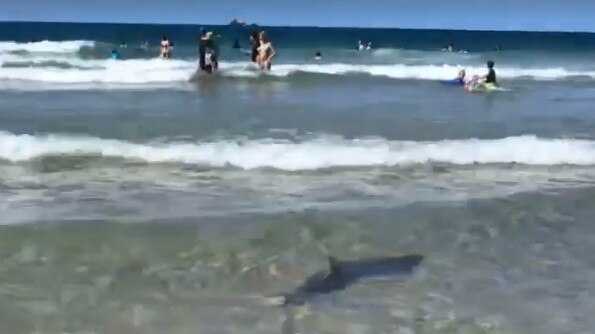Blood in the water but experts are still at sea on shark danger
It is increasingly dangerous to enter the surf but authorities are in denial.

Sharks causing beach closures became the new normal in Australia this summer.
Cid Harbour, in the world-famous Whitsundays, is permanently closed to swimmers, the pristine tropical environment spoiled with signs warning tourists never to swim there after three attacks, one fatal, in the past three months.
In a two-day period in NSW this week there were closures at Sydney, Hawks Nest, Forster, Lennox Head, Byron Bay and near Coffs Harbour.
In Western Australia on Boxing Day, an otherwise idyllic day, beaches were closed at City Beach-Floreat, Scarborough, Bunker Bay and Yallingup.
These are on top of dozens of shark sightings at more remote beaches where people now seldom swim or surf.
The process for a beach closure is usually an orderly one, with beach inspectors calmly but bossily telling everyone to get out of the water and installing signs warning of the danger.
But it’s not always that smooth. Michelle Batterham, from Ballina, NSW, was at Southwall, one of her local beaches, with a couple of other families the week before Christmas when a beach closure went slightly awry.
It began when she saw the shark-spotting helicopter about 500m south, flying low and circling a spot in the water, which is one of the many expensively ineffective ways authorities try to make beaches safe these days.
After a while it must have seemed to the helicopter pilot that it would be easier just to get everyone out of the water, Batterham says. So he flew the 500m to Southwall, hovered 10m above the water, turned on the siren and told everyone over a loudspeaker to evacuate the surf.
The response was not orderly.
“The kids were screaming and the parents were panicking. It was like a scene from Jaws,” Batterham says.
Batterham is not critical of the chopper pilot, who was just doing his job, she says.
She just wishes more proactive measures were in place to make surfers and swimmers safer.
Good luck with that. Despite the burgeoning toll from shark attacks, authorities are increasingly blase about this grim new reality.
Attacks are only a case of mistaken identity, says University of Newcastle marine ecologist Vincent Raoult, who told Nine’s newspapers last month that if humans were natural prey for sharks, there would be more attacks.
“It’s a smorgasbord for sharks if you go to Bondi. There are flavours from every nation,” he is quoted as saying, applying the anthropomorphism common in ecological studies these days.
When two people were killed by sharks in Western Australia in 2012, NSW Department of Primary Industries shark expert Vic Peddemors jokingly referred to them as a “bumper season”.
He also assured his audience that the rate of attacks soon would decrease. It has done the opposite.
University of Queensland researcher George Roff this month reported that the population of tiger sharks in that state had declined by 92 per cent in 50 years.
This conclusion was based solely on the numbers caught in the nets and drumlines installed to protect people at popular beaches in Queensland.
Like all academics, he favours preserving sharks while dismissing the risk of attacks.
“There is no strong evidence that reducing the number of sharks will make our beaches safer,” he tells Inquirer.
Bonnie Holmes, of the University of Queensland school of biological sciences, last year called for tiger sharks to join great whites on the protected-species list, but these days is reluctant to say why they should be protected.
After tiger sharks were suspected to have been the cause of two serious attacks in the Whitsundays in September, I called to ask politely if she still thought they should be protected. She did.
Asked why, she said: “Because I’ve spent the last 10 years of my life researching them.”
Then she hung up.
I called back again this month after a third — and fatal — attack at the same beach, possibly by a tiger shark. Her opinion remained unchanged, as did her unwillingness to elaborate.
The academic consensus that sharks are endangered is angrily disputed by Cairns fishing charter operator Daniel McCarthy, Katter Australia Party’s candidate for Leichhardt.
“They (tiger sharks) are all over the place, particularly in the last 15 years,” he says.
“The numbers are really spiking. They are having a significant impact on the food chain. The places where 20 years ago you rarely saw sharks — at beaches, river mouths and outside the reef in the Coral Sea, they are now in plague proportions.”
McCarthy is compiling videos of aggregations and “carnage” caused by sharks that he intends to take to Canberra to illustrate that the research being provided to MPs is “bullshit”.
The toll this summer easily could be far worse for another reason. You may not have noticed it yet but our beaches increasingly are becoming littered with dead whales, which are magnets to sharks, especially great whites. In Western Australia, 149 have been recorded this year. Last year there were only 24; the year before, 16.
The reason they strand themselves on the sand remains a mystery but their increasing number is not — they have been protected since 1979.
Surfers say if these carcasses are not removed quickly — or, worse, are buried — the oil from the decomposing whale will continue to attract sharks.
At Harrington beach, on the NSW mid-north coast, National Parks and Wildlife staff recently dragged a dead whale into the sand dunes and buried it without informing local surfers.
Dave Pearson, founder of the support group Bite Club, who lives in the area and has already been attacked once, says he refuses to surf at Harrington now.
“The surfers are seeing a lot of bull sharks there now,” he says, adding fishermen regularly are pulling 3m bull sharks out of the adjacent Manning River, at spots that 20 years ago were popular for swimming.
West Australian opposition tourism spokeswoman Libby Mettam recently asked the state’s Fisheries Minister, Dave Kelly, in parliament what would be done about a whale washed up at a remote beach near Margaret River, in her electorate, which was spooking local surfers.
Kelly’s reply included a condescending invitation to form a local volunteer group and to watch videos online of amateurs overseas exploding decaying whales.
“There are some great examples of people who have done some really foolish things with whale carcasses,” he said.
This month I asked federal Environment Minister Melissa Price if she had any idea when protection of great whites, now 20 years old, might be lifted.
Her spokesperson replied protection could not be lifted until the shark’s status had been considered by the Threatened Species Scientific Committee, and “the white shark is not currently under assessment by the committee”.
Her two predecessors, Josh Frydenberg and Greg Hunt, made similar responses to the same question while they were in the ministry.
The process of assessing protection is conspicuously slow.
The most recent announcement on the topic was in October last year when Nick Bax of the CSIRO told a Senate inquiry it would “be a number of years” before it could be ascertained whether the great white population was increasing, despite overwhelming anecdotal evidence to the contrary from surfers and fishermen.
So it looks as if this summer will be another with the risk of attacks greater than the last.
Meanwhile, as the number of sightings, encounters and attacks increase, so too do the ways in which environmentalists justify their stance.
According to a research paper published in October by University of Sydney academics Christopher Pepin-Neff and Thomas Wynter, coastal communities should feel “pride” about their aquatic man-eating neighbours.
“Much of the history of the human-shark relationship has been based on fear,” they write.
“For centuries, the goal has been to kill sharks that come near boats or beaches. Yet there is a growing trend of more positive feelings toward local shark populations. In this article, we demonstrate that feelings of pride toward sharks can serve as an opposing force to fear, and can moderate the way fear affects support for policies to kill sharks.”
How that helps people enjoy the beach is anybody’s guess.



To join the conversation, please log in. Don't have an account? Register
Join the conversation, you are commenting as Logout